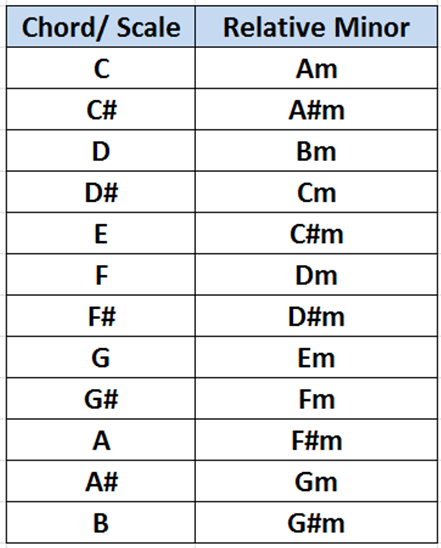The relative minor scale is widely used in improvisation because it allows more ideas for the solo. Every improviser who has learned how to use the major and minor scales must learn, right after that, how to use the relative minor scale.
But what is the relative minor scale?
Think of a major scale, for example, the C major scale. The C relative minor scale will be the A minor scale. As a rule, the relative minor scale of a major scale is the minor scale of the sixth degree of that tonality. Speaking like this seems confusing, but it is quite simple in practice. Since we were in C, the sixth degree is A, so just play A minor.
Note: if you are still a little lost on this subject of degrees, read the article “What are degrees?” again.
Well, as you can see, we are not learning any new scales here. This scale is nothing more than the natural minor scale we have seen; we are just creating a sixth degree link in relation to the first, and soon you will understand why.
If you take the C major scale and compare it with the A minor scale, you will see that they have exactly the same notes. That is, the major scale has a relative minor scale that is identical to it. Incredible, isn’t it? That is why the denomination “relative” is used. Compare below, for example, the C major x A minor and G major x E minor scales:
- C major scale: C, D, E, F, G, A, B
- A minor scale: A, B, C, D, E, F, G
- G major scale: G, A, B, C, D, E, F#
- E minor scale: E, F#, G, A, B, C, D
This is extremely useful! It means that we can use the A minor scale to solo a song whose tonality is C major. That is, whenever we have a major tonality, we can think of two scales: the major scale of that tonality and the relative minor scale of that tonality. This increases our options when thinking about the solo.
The relative major scale
In the same way, we can think of the inverse: every minor tonality has a relative major. This relative major is located 3 semitones above the minor tonality. For example, 3 semitones above A is C. Therefore, the relative major of A minor is C major.
The relative minor chord
It is worth noting that this concept also exists for chords. The relative minor chord is the sixth degree chord of the major key in question. For example, the C relative minor chord is the sixth degree chord of the C major key, that is, Am (or Am7). Another example: suppose the tonality is G major. The relative minor of G will be Em (or Em7).
As the relative chords have an affinity with each other, they can be exchanged for one another. We will see this in more detail in the study of harmonic functions. For now, think about the scales, remember that you can always use the relative minor along with the major scale.
How to exercise
Try it out by taking a song in the major key and playing the relative minor on top of it. See how it fits perfectly?
Now that you’ve learned what you needed to know about the relative minor, try to find the relative minor of all major chords or scales. Then, check with the table below:

Go to: Counter Parallel Chords
Back to: Module 5